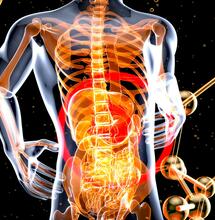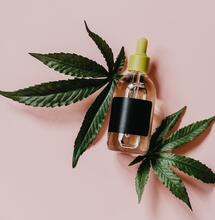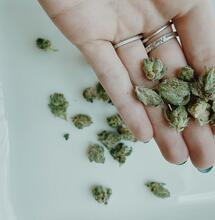Decarboxylation and Solubilization
08 Jun 2019

Cannabis Butter
Raw cannabis is generally non-intoxicating but may have some psychoactive effects depending on how much free THC is present versus THCA. Patients report that the therapeutic effects of raw cannabis include providing relief from spasticity and inflammation and some reported no therapeutic effect. Raw cannabis is generally non-intoxicating but may have some psychoactive effects depending on how much free THC is present versus THCA. Patients report that the therapeutic effects of raw cannabis include providing relief from spasticity and inflammation and some reported no therapeutic effect. Cannabinoids are found in the form of acids (THCA) and attached to the carboxylic group (COOH). It must first be “liberated”; that is, cannabinoids including THC must change from an acid to a nonacid form to become psychoactive.
Cannabinoids are found in the form of acids (THCA) and attached to the carboxylic group (COOH). It must first be “liberated”; that is, cannabinoids including THC must change from an acid to a nonacid form to become psychoactive.
 The process of decarboxylation converts CBD and non-psychoactive THC acid found in raw cannabis to psychoactive nonacid THC. Decarboxylation converts CBD to its nonacid form, which is extremely therapeutic.
The process of solubilization also converts CBD and THC found in dry cannabis from their acid forms to their
nonacid forms. Decarboxylation and solubilization, achieve the same end but through different processes.
The process of decarboxylation converts CBD and non-psychoactive THC acid found in raw cannabis to psychoactive nonacid THC. Decarboxylation converts CBD to its nonacid form, which is extremely therapeutic.
The process of solubilization also converts CBD and THC found in dry cannabis from their acid forms to their
nonacid forms. Decarboxylation and solubilization, achieve the same end but through different processes.
 Decarboxylation is a chemical reaction that releases carbon dioxide (CO2). Decarboxylation of cannabis denotes a reaction of carboxylic acids, removing a carbon atom from a carbon chain.
Decarboxylation can be achieved by heating THC-dominant dry canna bis to above 100ºC or heating CBD-dominant dry cannabis to above 146ºC for 60 to 90 minutes. Do not heat cannabis – both THC-dominant and CBD-dominant – to above 160ºC to prevent boiling off cannabinoids. Heating beyond 160ºC may cause desirable cannabinoids, CBD and THC, to volatize and be lost when they mix with the air.
Decarboxylation is a chemical reaction that releases carbon dioxide (CO2). Decarboxylation of cannabis denotes a reaction of carboxylic acids, removing a carbon atom from a carbon chain.
Decarboxylation can be achieved by heating THC-dominant dry canna bis to above 100ºC or heating CBD-dominant dry cannabis to above 146ºC for 60 to 90 minutes. Do not heat cannabis – both THC-dominant and CBD-dominant – to above 160ºC to prevent boiling off cannabinoids. Heating beyond 160ºC may cause desirable cannabinoids, CBD and THC, to volatize and be lost when they mix with the air.
 Decarboxylation also occurs rapidly during vaporization: heating cannabis to 187.8ºC–193ºC, at which point it vaporizes and the conversion to the “active” nonacidic form takes place. Do not heat above 193ºC or it may cause preliminary burning/charring. This process frees molecules to convert into carbon dioxide (CO2) and water vapor (H2O).
Decarboxylation also occurs rapidly during vaporization: heating cannabis to 187.8ºC–193ºC, at which point it vaporizes and the conversion to the “active” nonacidic form takes place. Do not heat above 193ºC or it may cause preliminary burning/charring. This process frees molecules to convert into carbon dioxide (CO2) and water vapor (H2O).
 Note: THC is liberated rapidly at temperatures between 187.8ºC–193ºC, and CBD is liberated rapidly at 187.8ºC –193ºC. The other 80+ known cannabinoids volatize at different temperatures often lower than 193ºC.
The same decarboxylation process also occurs at a very rapid rate when cannabis combusts (burns). Heat in smoked cannabis causes THC to convert into the psychoactive form. CBD is converted into its nonacid form. Combustion releases many toxic compounds—aromatic hydrocarbons such as benzopyrene and other carcinogens—that are inhaled into the lungs.
See www.marijuanagrowing.com for more information.
Note: THC is liberated rapidly at temperatures between 187.8ºC–193ºC, and CBD is liberated rapidly at 187.8ºC –193ºC. The other 80+ known cannabinoids volatize at different temperatures often lower than 193ºC.
The same decarboxylation process also occurs at a very rapid rate when cannabis combusts (burns). Heat in smoked cannabis causes THC to convert into the psychoactive form. CBD is converted into its nonacid form. Combustion releases many toxic compounds—aromatic hydrocarbons such as benzopyrene and other carcinogens—that are inhaled into the lungs.
See www.marijuanagrowing.com for more information.
 Cannabinoids are soluble in fats, sugars, and oils (lipids), alcohol, and other oil-based solvents. Once combined, cannabinoids are soluble and convert from the acid to the nonacid form. THC becomes psy-choactive, and CBD becomes much more therapeutic.
Solubilization occurs when cannabis is mixed with fats, sugar, oils, alcohol, and other oil-based solvents. The cannabinoids migrate and concentrate in the solvents.
Cannabinoids are soluble in fats, sugars, and oils (lipids), alcohol, and other oil-based solvents. Once combined, cannabinoids are soluble and convert from the acid to the nonacid form. THC becomes psy-choactive, and CBD becomes much more therapeutic.
Solubilization occurs when cannabis is mixed with fats, sugar, oils, alcohol, and other oil-based solvents. The cannabinoids migrate and concentrate in the solvents.
 Combine cannabis with these solvents, and heat at low temperatures (50ºC –62.8ºC) for 60 to 90 minutes to solubilize (extract) cannabinoids. Simmering and stirring ensures that complete extraction occurs.
Combine cannabis with these solvents, and heat at low temperatures (50ºC –62.8ºC) for 60 to 90 minutes to solubilize (extract) cannabinoids. Simmering and stirring ensures that complete extraction occurs.
 Combining cannabis with alcohol (spirits or glycerin) requires no heat, but the process takes much longer. For example, place a bud in a bottle of ethyl alcohol—vodka, rum, or spirits of any kind. Over time the alcohol will take on the flavor and the potency of the cannabis. Or the alcohol can be evaporated to leave a concentrate.
Combining cannabis with alcohol (spirits or glycerin) requires no heat, but the process takes much longer. For example, place a bud in a bottle of ethyl alcohol—vodka, rum, or spirits of any kind. Over time the alcohol will take on the flavor and the potency of the cannabis. Or the alcohol can be evaporated to leave a concentrate.
 Carbon dioxide (CO2) can also be used as a solvent to liberate cannabinoids. CO2 is becoming a popular method to extract CBD and THC from dry cannabis.
Carbon dioxide (CO2) can also be used as a solvent to liberate cannabinoids. CO2 is becoming a popular method to extract CBD and THC from dry cannabis.



